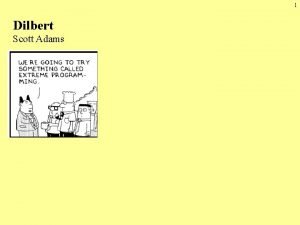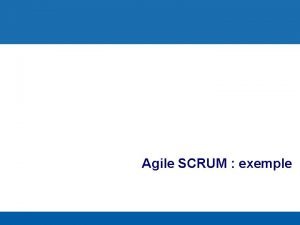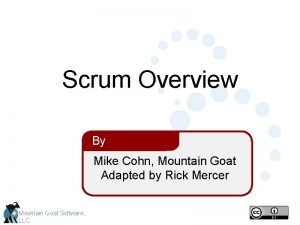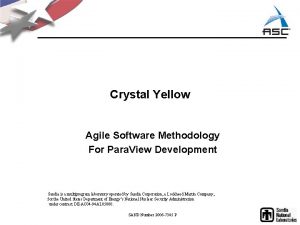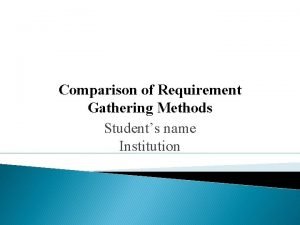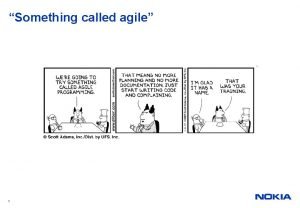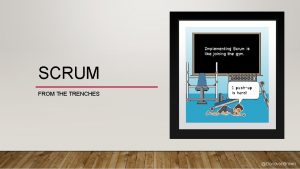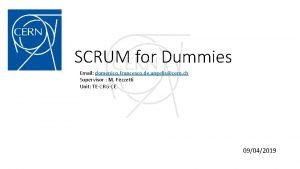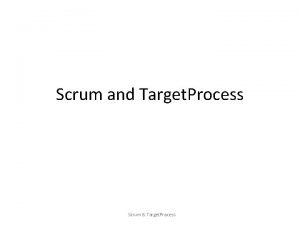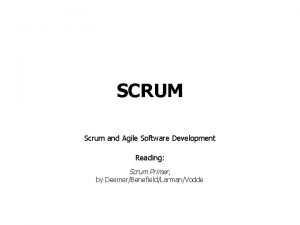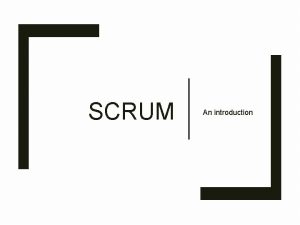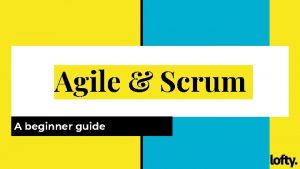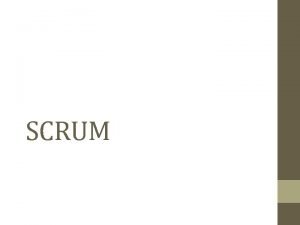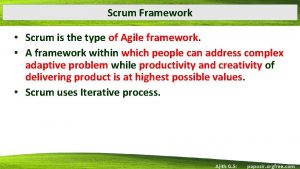Agile Methodology and Scrum 1 What is Agile













- Slides: 13

Agile Methodology and Scrum 1

What is Agile ? • Agile proponents believe • Current software development processes are too heavyweight or cumbersome • Too many things are done that are not directly related to software product being produced • Current software development is too rigid • Difficulty with incomplete or changing requirements • Short development cycles (Internet applications) • More active customer involvement needed

What is Agile ? Continued • Agile methods are considered • Lightweight • People-based rather than Plan-based • Several agile methods • No single agile method • No single definition • Agile Manifesto closest to a definition • Set of principles • Developed by Agile Alliance

Agile Manifesto A Statement of Values • Individuals and interactions over processes and tools • Working software over comprehensive documentation • Customer collaboration over contract negotiation • Responding to change over following a plan • http: //www. agilemanifesto. org

Agile Methods • Agile methods: • • • Scrum Extreme Programming Adaptive Software Development (ASD) Dynamic System Development Method (DSDM) … • Agile Alliance (www. agilealliance. org) • A non-profit organization promotes agile development

A Brief Description of Scrum • Scrum is an agile process that allows developers to focus on delivering the highest business value in the shortest time. • It allows developers to rapidly and repeatedly inspect actual working software (every two weeks to one month). • The business sets the priorities. Teams self-manage to determine the best way to deliver the highest priority features. • Every two weeks to a month anyone can see real working software and decide to release it as is or continue to enhance for another iteration.

Characteristics of Scrum • Self-organizing teams • Product progresses in a series of month-long “sprints” • Requirements are captured as items in a list of “product backlog” • No specific engineering practices prescribed • Uses generative rules to create an agile environment for delivering projects • One of the “agile processes”

Sprints • Scrum projects make progress in a series of “sprints” • Target duration is one month • +/- a week or two • But, a constant duration leads to a better rhythm • Product is designed, coded, and tested during the sprint

Sprint • A month-long iteration, during which product functionality is incremented • NO changes during the sprint. • Plan sprint durations around how long you can commit to keeping change out of the sprint • NO outside influence can interfere with the Scrum team during the Sprint • Each Sprint begins with the Daily Scrum Meeting Change Inputs Sprint Tested Code

Daily Scrum • Parameters • Daily • 15 -minutes • Stand-up • Not for problem solving • Three questions: 1. What did you do yesterday 2. What will you do today? 3. What obstacles are in your way?

Daily Scrum • Is NOT a problem solving session • Is NOT a way to collect information about who is behind the schedule • Is a meeting in which team members make commitments to each other and to the Scrum Master • Is a good way for a Scrum Master to track the progress of the Team

Scrum FAQs • Why daily? • “How does a project get to be a year late? ” • “One day at a time. ” • Fred Brooks, The Mythical Man-Month. • Can Scrum meetings be replaced by emailed status reports? • No • Entire team sees the whole picture every day • Create peer pressure to do what you say you’ll do

Advantages and Disadvantages Advantages • • Completely developed and tested features in short iterations Simplicity of the process Clearly defined rules Increasing productivity Self-organizing Each team member carries a lot of responsibility Improved communication Disadvantages • • Can lead to “undisciplined hacking” (no written documentation) Can lead to violations of responsibility
 Agile game development
Agile game development Scrum for beginners
Scrum for beginners Agile inception
Agile inception Ikiwisi
Ikiwisi Exemple de product backlog
Exemple de product backlog Scrum mountain goat
Scrum mountain goat Crystal agile methodology
Crystal agile methodology Requirements gathering techniques agile
Requirements gathering techniques agile Scrum master bulldozer and shield
Scrum master bulldozer and shield Scrum from the trenches
Scrum from the trenches What are the 3 artifacts of scrum?
What are the 3 artifacts of scrum? Target process
Target process Scrum words
Scrum words Team foundation server scrum
Team foundation server scrum



